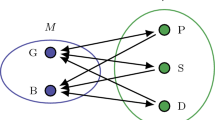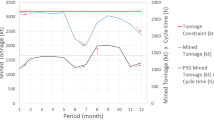Abstract
In many underground mines, haulage vehicles carry ore from underground loading stations to the surface. Vehicles travel in narrow tunnels with occasional passing bays that allow descending empty vehicles to pull off the main path and wait for ascending laden vehicles to pass. The number of passing bays and their locations influence the delays to descending vehicles, and hence the haulage productivity of the mine. We formulate and solve a mixed integer programming (MIP) model to determine the optimal locations of passing bays to maximise haulage productivity for given numbers of vehicles and passing bays. The MIP also generates the corresponding vehicle schedule. Previous studies have only examined the placement of equally spaced bays. The results obtained from the MIP show that this is not always optimal. Furthermore, we observe that the best locations of passing bays are those that allow interleaving of vehicles without delays at bays.








Similar content being viewed by others
References
Anjomshoa H (2011). Optimal placement of passing bays in underground mines. PhD thesis, University of South Australia.
Anjomshoa H, Lee DH, Pudney PJ, Albrecht AR and Mackenzie SA (2010). Passing bays in an underground mine. Mining Technology 119 (1): 31–33.
Higgins A, Kozan E and Ferreira L (1997). Modelling the number and location of sidings on a single line railway. Computers and Operations Research 24 (3): 209–220.
Hoare RT and Willis RJ (1992). A case study of animated computer simulation in the Australian mining industry. Journal of the Operational Research Society 43 (12): 1113–1120.
Luscombe R and Lee DH (2005). Identifying key infrastructure changes to improve rail network performance. In: Proceedings of the ASOR 18th National Conference, Perth, Western Australia.
Mills G, Perkins S and Sier D (1993). Capacity planning for a railway corridor. In: Proceedings of the ASOR 12th National Conference, Adelaide, South Australia.
Petersen ER and Taylor AJ (1987). Design of single-track rail line for high-speed trains. Transportation Research Part A: General 21 (1): 47–57.
Roberts BH (2002). Computer simulation of underground truck haulage operations. Mining Technology 111 (2): 123–128.
Runciman N, Vagenas N and Corkal T (1997). Simulation of haulage truck loading techniques in an underground mine using WITNESS. Simulation 68 (5): 291–299.
Sturgul JR, Jacobsen WL and Tecsa TL (1996). Modeling two-way traffic flow in an underground one-way decline. In: Proceedings of the Fifth International Symposium on Mine Planning and Equipment Selection, Sao Paulo, Brazil.
Author information
Authors and Affiliations
Corresponding author
Rights and permissions
About this article
Cite this article
Anjomshoa, H., Albrecht, A., Lee, D. et al. Optimising passing bay locations and vehicle schedules in underground mines. J Oper Res Soc 64, 241–249 (2013). https://doi.org/10.1057/jors.2012.42
Received:
Accepted:
Published:
Issue Date:
DOI: https://doi.org/10.1057/jors.2012.42




